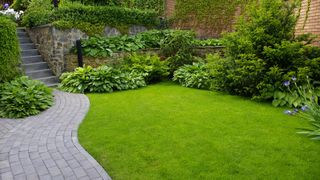Of course, in order to get your lawn in shape, it’s handy to have one of the best lawn edgers (opens in new tab) on hand, as they’re packed to the brim with features that make the task easier. Sometimes referred to as strimmers, in essence, electric lawn edgers are handheld devices with a spinning head at the bottom, that rotate to cut through your lawn and soil to carve out space, like walkways. Manual edgers are less complex; they are essentially specialist shovels that require more physical work to shift grass and soil. Now you’re set on the facts of the business, let’s get on with how to use one to create your own personal slice of lawn paradise.
How to edge a lawn
Undertake essential preparations Edging your lawn should always be preceded by a general neatening up of your lawn, starting with mowing the grass. Aided with the best electric lawn mowers (opens in new tab) or the best gas lawn mowers (opens in new tab), you should give your space an all-over cut, making sure not to cut the grass too short depending on the climate you’re living in and the type of soil you’re working with. Once that’s done, then plot out the parts of your lawn you want to edge to get that ultra-neat look. That might be walkways, which are easy enough to remember, but if it’s anything more complex, like carving out space between flowerbeds then use a guide, like a rope or a hose, to lay next to the areas to give you a template to work with. When you do set out, edge between the guide and the grass for a clean and polished look, like coloring between the lines. Know your tool As with any gardening tool, there are a myriad of variations when it comes to the device you’re wielding. If you’re just starting out, then models with a guide wheel can be really helpful to glide along the grass and help you stay steady, as well as lightweight finds that are easier to have in a comfortable position. Get familiar with the edger you have, and make sure you’ve followed all necessary safety information before you begin. Overall, the position you take should remain the same throughout the whole process, so when using an electric strimmer, keep your core engaged and your arms straight. Consider upgrading to a more lightweight model if this isn’t possible, for your safety and optimal results. Start at the edges It’s sort of a no-brainer, but it’s crucial when you’re edging your lawn to start with the biggest job, which is the perimeter. Go slowly as you start, especially if you’re a beginner, and gauge your control and how deep the cuts you’re making are. If you’ve laid one out to follow, then take note of the guidelines on the ground, or keep to your designated walkway to prevent any landscaping disasters. Near any sort of obstacles, like flowerbeds, trees or cables, take your time and slow your pace; this will make the end result a lot more aesthetically pleasing too. Go around the entire boundary, and then get stuck into the more complex operations if you’re carving out separate spaces between flowerbeds for example. As you work, make sure you’re taking a look at your previous efforts, and self-correcting if your physical form isn’t quite right. Clean as you go Once you’ve finished edging, you’re going to want to remove all of the materials you’ve dredged up in order to get that picture-perfect lawn. That includes taking care of your edging tool as well, so the next time you need it the whole process can be a total breeze. Lots of edgers have dual functions, so if you have the capability, then you can also give a once-over to any stubborn plants with your weedwhacker, and rest easy knowing you’ve mastered your green space. With this task all tied up, the next time you edge your lawn should be much easier given that you keep up the maintenance, so you can kick back and feel smug about your wonderful lawn. Discover more garden guides… Best patio heaters (opens in new tab) Best chainsaws (opens in new tab) Best gas grills (opens in new tab) Best pool heaters (opens in new tab) Best hot tubs (opens in new tab) Best swim spas (opens in new tab)








